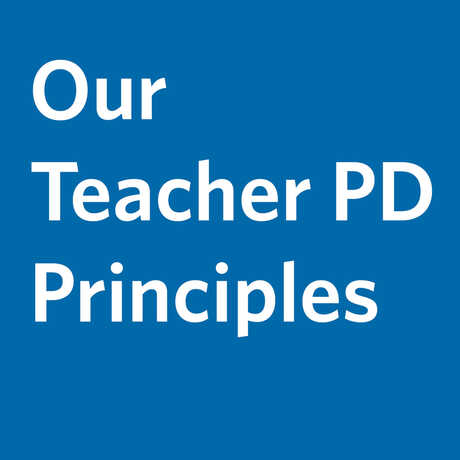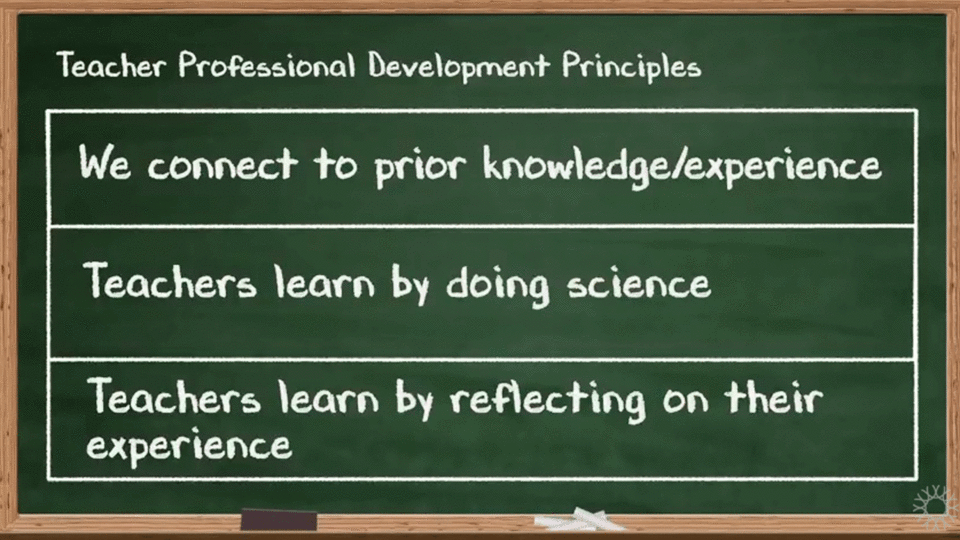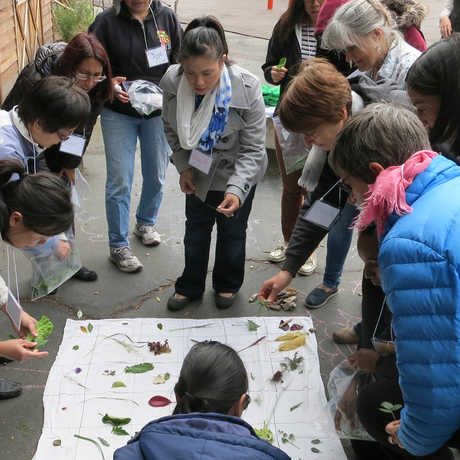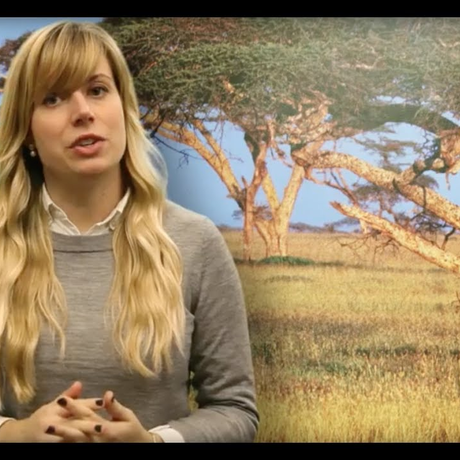The Academy is taking time off from our Teacher Professional Development work this summer to strategize about future programming. Please stay tuned for more details, and join our email list to stay in the loop.
Below we describe the principles that guide our work in creating and facilitating effective learning experiences for teachers. Each principle is based not only on our own experience, but also on feedback from the hundreds of teachers our team has supported, and on a solid body of educational research.
Note that we work specifically with science teachers, and that is reflected in some of these principles. However, most of these ideas are true for all adult learners, regardless of their field.
We hope you find these ideas useful in shaping your own perspective on high quality professional development and facilitation.
Our Teacher Professional Development Principles
Click the + next to each principle to see details and related strategies. If it feels like a lot to take in, perhaps focus on growing your skill in one principle first, then tackle others later on.
- We don’t lecture; we facilitate experiences
- Teachers get to be science learners and participate in activities
- We allow time for meaning-making
- We allow time for teachers to reflect on their learning
- Teachers plan for how to transfer their learning into their teaching
Strategies to support this principle:
- Do science: In a science PD, teachers should participate in science activities as learners. While you may need to take an occasional shortcut for the sake of time, try to make the experience as close to a genuine student experience as possible. More tips here: https://www.calacademy.org/educators/teachers-as-learners
- Reflect: Give ample time for teachers to reflect on the science learning experience. Use consistent prompts to frame the reflection. For example:
- What was that experience like for you as a learner?
- What strategies or teacher moves did you notice?
- What worked well for you, and what didn’t?
- Make clear transitions between “student hat” and “teacher hat”: Use a consistent routine to let participants know when to act as a learner (and pause their teacher-level questions), and when to switch back into teacher mode.
- Make time for operationalizing: Give time and guidance for participants to apply new ideas to their own work. Give time to make a plan for implementation while the learning is fresh, and to record ideas for future reference
- Group by grade level: Science learning can be awesome in mixed-grade groups, but consider transitioning to grade-alike groups for reflection and application time. Relevance supports applicability.
- We use strategies to increase the number and diversity of voices that are heard
- We provide structure to support group work
- We balance whole group, small group, and individual experiences
- Teachers can participate in multiple ways, verbally and non-verbally
- We design accessible experiences with affordable materials
- We give clear directions, and make all directions visible
Strategies to support this principle:
- Group share order: Give a clear, fast way to decide who should share first in a small group discussion, such as: person with the longest hair, person who woke up earliest, person who ate cheese most recently, etc. This prevents the same voice(s) from constantly dominating the discussion. Do this for in-person groups AND for virtual breakout rooms.
- Group roles: Assign roles for participants to play in groups (or breakout rooms). Example: person with name closest to beginning of alphabet facilitates, person with name closest to end of alphabet takes notes.
- Six hands: In whole group discussions, invite participants to raise their hands to share their thoughts. Instead of calling on the first person to raise their hand, wait until you see 6 hands raised. Then you can call on those 6 people in any order, prioritizing voices that haven't been heard as much.
- Elevating voices: If you will have a whole group discussion following a small group work, spend some time eavesdropping on the groups. When you notice a participant sharing something interesting, ask if they’d be willing to share it in the whole group discussion. You can target people whose voices haven’t been heard as much.
- Reflection choice: Where possible, give participants the option to respond to reflection prompts verbally with a small group, or independently by journaling.
- Vary ways to process and interact:
- Time to think and work individually, in a small group, and in the whole group.
- Opportunities to read, write, listen, watch, talk, interact virtually (e.g. padlet, jamboard, slides)
- Even in virtual PDs, include some off-screen tasks: writing, sketching, hands-on activities, moving around, going outside
- Give ample time for chat shares: In virtual workshops, when you invite participants to share thoughts or questions in the chat, give plenty of time to enable everyone to participate, regardless of their typing or reading speed.
- Redundant directions: Provide multiple ways to access instructions and info about what is happening in the session. For example:
- Say it out loud
- On slides
- On the board / big sticky
- In the chat for a virtual PD
- On a website or shared doc
- Access to directions: In virtual workshops, make sure directions for tasks or discussions will be visible to participants while they are in the breakout rooms:
- Paste in the chat before opening rooms, or
- Direct to a website or doc before opening rooms
- We make time for teachers to connect with each other, even in short PDs
- In longer PDs, we spend time building community
- We remember that productive group talk takes time, and is worth prioritizing
- Teachers share their ideas and learn from each other
- We learn from teachers too
Strategies to support this principle:
- Use icebreakers and energizers: These are short activities that can be fun, energizing, reflective, or even meditative. While they may seem trivial, they actually serve important purposes, such as helping participants transition into the right headspace, focusing their attention, and building community. Talking, playing, laughing, or breathing together can be powerful ways to connect as humans. More tips here:https://www.calacademy.org/educators/icebreakers-and-energizers
- Use norms or community agreements: Particularly for a group that meets regularly, norms help create a culture where everyone feels comfortable and able to learn. More tips here:https://www.calacademy.org/educators/norms-for-professional-learning
- Group intros: When participants get into a small group with new people, build in time for them to introduce themselves, and give explicit directions to do so.
- Create ways for teachers to share their ideas, wisdom, and experience: For example, use poster paper, padlets, or jamboards where participants can share their thinking.
- Make time for socializing: When possible, make the time in small groups/breakout rooms long enough that people can chat a little bit after completing their assigned task.
- Choose your own groups: When appropriate, allow participants to self-select into a group to talk with. You could offer different options based on discussion topic, grade level, or other factors. You can also give participants the option to work independently rather than with a group. (In zoom, this can be accomplished with the choose-your-own breakout room function.)
- We set clear goals focused on useful outcomes, and share them publicly
- We are realistic about how much we can do in the time available
- We make clear what teachers can expect and not expect
- Teachers leave with at least one thing they can use right away
- We solicit teacher feedback and use it to inform our PD design
Strategies to support this principle:
- Start on time, end on time:
- Start within 5 minutes of listed start time
- Have a "Do Now" to help folks settle in and get engaged while they wait that short time.
- Do not go over time at the end. Really, just don’t.
- Give ample time to each activity: You might need to do fewer things so that each thing can really be meaningful and a good use of time. Tips:
- Have clear goals for the session while you plan it
- Use your goals to prioritize and remove components that aren't meeting the goals
- Try out activities ahead of time so you know how long they will really take
- Do time checks: Ask participants how many more minutes they need for something (they can show this by holding up a number of fingers), especially when they are doing an individual activity like reading or reflection.
- Make sure participants gain something they can use the next day: This doesn't have to be a ready-to-go lesson. It could be a strategy or set of strategies that are easily implemented. The time in the PD will feel more valuable if they walk away with something they can use right away, even if other ideas and resources might take more time to process.
- Take participant feedback seriously: To make your PD worth the teachers’ time, you need to take their input seriously and make changes in response to their feedback. Be sure to leave a few minutes at the end of every session to collect some anonymous feedback. More tips here:https://www.calacademy.org/educators/feedback-and-assessment-in-professional-learning
- We feed participants
- We give participants breaks at least every 2 hours
- Teachers can take care of their personal business (step out for phone calls, leave when needed)
- We move at a moderate and accessible pace
- We don’t introduce too many tech tools or platforms at once
Strategies to support this principle:
- Provide snacks: Even a simple snack goes a long way in helping people feel cared for, comfortable, and ready to learn.
- Include breaks! For any session longer than 90 minutes, schedule breaks into the agenda. Let participants know when the break will be so they can plan ahead and manage their needs accordingly.
- Make break timing visible: Display the end time for the break on screen or on the board, and/or display a countdown timer showing how much time is left. This reduces stress and makes it easier for participants to focus on managing their needs.
- Keep slides simple: Reduce cognitive overload with easily readable slides. Use slides to illustrate, supplement, and help clarify instructions or important points. If there is a lot to read on a slide, give ample quiet time to read it and/or read it out loud.
- Organize all resources and documents in a central place: Google sites is one tool we use, but this can also be as simple as a google doc or slide deck. The important thing is that everything used in the workshop can easily be found in one organized location.
- Minimize number of digital platforms/tools: Each new tech tool or platform that you introduce adds cognitive load! It’s easy to forget this when we are already comfortable with the tools ourselves, but remember your participants may not be there yet. Minimize the number of tech tools you use, and focus on one or two that best support your goals
- Practice tech tools: Create a "Do Now," icebreaker, or other low stakes activity that uses the tech tool you are introducing. Let participants practice and get comfortable with it before using it for learning.






